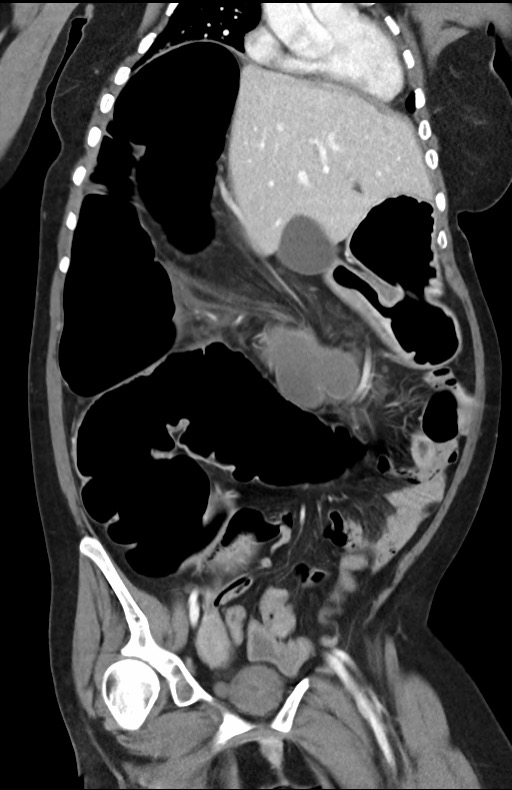Sunday Poster Session
Category: Colon
P0337 - Successful Endoscopic Decompression of Transverse Colon Volvulus Case Report
Sunday, October 26, 2025
3:30 PM - 7:00 PM PDT
Location: Exhibit Hall
- MM
Mubeen Khan Mohammed Abdul, MD
Mercyhealth
Rockford, IL
Presenting Author(s)
Mubeen Khan Mohammed Abdul, MD1, Luqman Baloch, MD1, Ammar Aqeel, MD1, Abu Fahad Abbasi, MD2, Ahmet Sakiri, MD2, Thayer Hamoudah, MD3, Kyoko Misawa, MD1, Altaf Dawood, MD3, Baseer Qazi, MD3, Naser Khan, MD3
1Mercyhealth, Rockford, IL; 2Mercy Health, Rockford, IL; 3Mercyhealth Gastroenterology, Rockford, IL
Introduction: Transverse colon volvulus accounts for 4% of colon volvulus presentation. Patients usually require emergent surgical intervention. We present a case of successful endoscopic decompression of transverse colon volvulus.
Case Description/
Methods: A 27-year-old female with a history of Coffin-Siris syndrome, gastric ulcer, severe intellectual disabilities, seizure disorder, transferred from Children’s Home Center for evaluation of a two-day history of progressive abdominal distension and lack of Bowel movements associated with increased burping with G tube usage.
Abdominal examination showed severe distension of the abdomen and firm to palpation with demonstration of pain behavior upon examination. Vitals were stable.
Labs were pertinent for mild leukocytosis without any evidence of electrolyte abnormalities.
CT Abdomen and Pelvis with Contrast showed acute large bowel obstruction secondary to volvulus of the distal transverse colon. Mesenteric edema of the transverse and descending colon was suspicious for impending bowel compromise. Surgical consultation was obtained. The patient’s family opted for an endoscopic attempt to decompress the volvulus.
Flexible sigmoidoscopy subsequently identified Transverse colon volvulus, with viable appearing mucosa in the distal transverse colon. Decompression of the volvulus was attempted with success. A colon decompression tube was placed. Abdominal distension immediately improved. Family deferred the surgical approach, and the patient was discharged in stable condition.
Discussion: Transverse colon volvulus is a rare cause of acute abdomen. Hepatic and splenic flexure fixation along with short meso-colon prevents transverse colon volvulus.
If patients are hemodynamically stable without vascular compromise, then endoscopic evaluation can be attempted. If endoscopic decompression is unsuccessful, then a surgical approach is recommended.

Figure: CT Abdomen and pelvis with Transverse Colon Volvulus.

Figure: Transverse colon Volvulus Before and After Endoscopic Decompression.
Disclosures:
Mubeen Khan Mohammed Abdul indicated no relevant financial relationships.
Luqman Baloch indicated no relevant financial relationships.
Ammar Aqeel indicated no relevant financial relationships.
Abu Fahad Abbasi indicated no relevant financial relationships.
Ahmet Sakiri indicated no relevant financial relationships.
Thayer Hamoudah indicated no relevant financial relationships.
Kyoko Misawa indicated no relevant financial relationships.
Altaf Dawood indicated no relevant financial relationships.
Baseer Qazi indicated no relevant financial relationships.
Naser Khan indicated no relevant financial relationships.
Mubeen Khan Mohammed Abdul, MD1, Luqman Baloch, MD1, Ammar Aqeel, MD1, Abu Fahad Abbasi, MD2, Ahmet Sakiri, MD2, Thayer Hamoudah, MD3, Kyoko Misawa, MD1, Altaf Dawood, MD3, Baseer Qazi, MD3, Naser Khan, MD3. P0337 - Successful Endoscopic Decompression of Transverse Colon Volvulus Case Report, ACG 2025 Annual Scientific Meeting Abstracts. Phoenix, AZ: American College of Gastroenterology.
1Mercyhealth, Rockford, IL; 2Mercy Health, Rockford, IL; 3Mercyhealth Gastroenterology, Rockford, IL
Introduction: Transverse colon volvulus accounts for 4% of colon volvulus presentation. Patients usually require emergent surgical intervention. We present a case of successful endoscopic decompression of transverse colon volvulus.
Case Description/
Methods: A 27-year-old female with a history of Coffin-Siris syndrome, gastric ulcer, severe intellectual disabilities, seizure disorder, transferred from Children’s Home Center for evaluation of a two-day history of progressive abdominal distension and lack of Bowel movements associated with increased burping with G tube usage.
Abdominal examination showed severe distension of the abdomen and firm to palpation with demonstration of pain behavior upon examination. Vitals were stable.
Labs were pertinent for mild leukocytosis without any evidence of electrolyte abnormalities.
CT Abdomen and Pelvis with Contrast showed acute large bowel obstruction secondary to volvulus of the distal transverse colon. Mesenteric edema of the transverse and descending colon was suspicious for impending bowel compromise. Surgical consultation was obtained. The patient’s family opted for an endoscopic attempt to decompress the volvulus.
Flexible sigmoidoscopy subsequently identified Transverse colon volvulus, with viable appearing mucosa in the distal transverse colon. Decompression of the volvulus was attempted with success. A colon decompression tube was placed. Abdominal distension immediately improved. Family deferred the surgical approach, and the patient was discharged in stable condition.
Discussion: Transverse colon volvulus is a rare cause of acute abdomen. Hepatic and splenic flexure fixation along with short meso-colon prevents transverse colon volvulus.
If patients are hemodynamically stable without vascular compromise, then endoscopic evaluation can be attempted. If endoscopic decompression is unsuccessful, then a surgical approach is recommended.

Figure: CT Abdomen and pelvis with Transverse Colon Volvulus.

Figure: Transverse colon Volvulus Before and After Endoscopic Decompression.
Disclosures:
Mubeen Khan Mohammed Abdul indicated no relevant financial relationships.
Luqman Baloch indicated no relevant financial relationships.
Ammar Aqeel indicated no relevant financial relationships.
Abu Fahad Abbasi indicated no relevant financial relationships.
Ahmet Sakiri indicated no relevant financial relationships.
Thayer Hamoudah indicated no relevant financial relationships.
Kyoko Misawa indicated no relevant financial relationships.
Altaf Dawood indicated no relevant financial relationships.
Baseer Qazi indicated no relevant financial relationships.
Naser Khan indicated no relevant financial relationships.
Mubeen Khan Mohammed Abdul, MD1, Luqman Baloch, MD1, Ammar Aqeel, MD1, Abu Fahad Abbasi, MD2, Ahmet Sakiri, MD2, Thayer Hamoudah, MD3, Kyoko Misawa, MD1, Altaf Dawood, MD3, Baseer Qazi, MD3, Naser Khan, MD3. P0337 - Successful Endoscopic Decompression of Transverse Colon Volvulus Case Report, ACG 2025 Annual Scientific Meeting Abstracts. Phoenix, AZ: American College of Gastroenterology.
